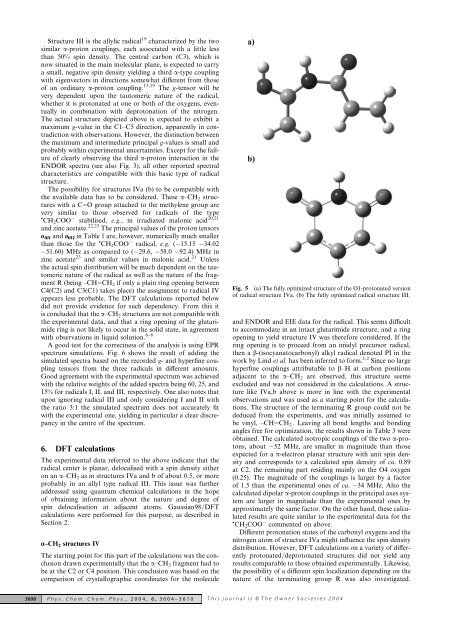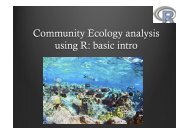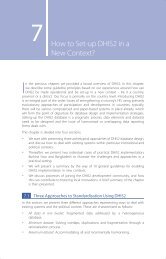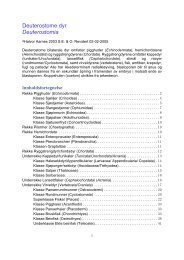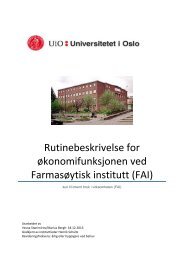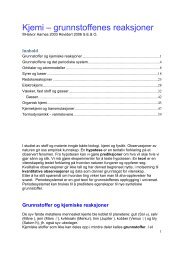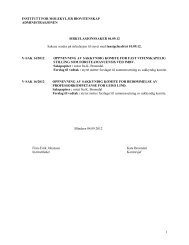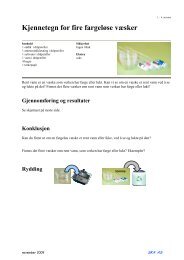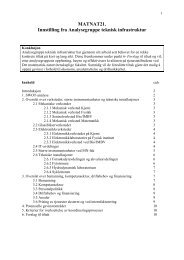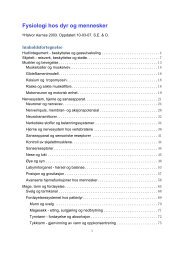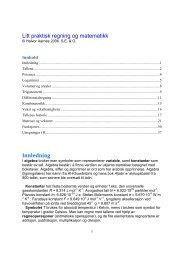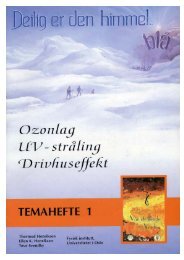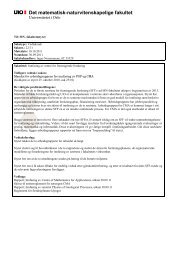Allyl type radical formation in X-irradiated glutarimide crystals ...
Allyl type radical formation in X-irradiated glutarimide crystals ...
Allyl type radical formation in X-irradiated glutarimide crystals ...
Create successful ePaper yourself
Turn your PDF publications into a flip-book with our unique Google optimized e-Paper software.
Structure III is the allylic <strong>radical</strong> 19 characterized by the twosimilar a-proton coupl<strong>in</strong>gs, each associated with a little lessthan 50% sp<strong>in</strong> density. The central carbon (C3), which isnow situated <strong>in</strong> the ma<strong>in</strong> molecular plane, is expected to carrya small, negative sp<strong>in</strong> density yield<strong>in</strong>g a third a-<strong>type</strong> coupl<strong>in</strong>gwith eigenvectors <strong>in</strong> directions somewhat different from thoseof an ord<strong>in</strong>ary a-proton coupl<strong>in</strong>g. 13,19 The g-tensor will bevery dependent upon the tautomeric nature of the <strong>radical</strong>,whether it is protonated at one or both of the oxygens, eventually<strong>in</strong> comb<strong>in</strong>ation with deprotonation of the nitrogen.The actual structure depicted above is expected to exhibit amaximum g-value <strong>in</strong> the C1–C5 direction, apparently <strong>in</strong> contradictionwith observations. However, the dist<strong>in</strong>ction betweenthe maximum and <strong>in</strong>termediate pr<strong>in</strong>cipal g-values is small andprobably with<strong>in</strong> experimental uncerta<strong>in</strong>ties. Except for the failureof clearly observ<strong>in</strong>g the third a-proton <strong>in</strong>teraction <strong>in</strong> theENDOR spectra (see also Fig. 3), all other reported spectralcharacteristics are compatible with this basic <strong>type</strong> of <strong>radical</strong>structure.The possibility for structures IVa (b) to be compatible withthe available data has to be considered. These a–CH 2 structureswith a C=O group attached to the methylene group arevery similar to those observed for <strong>radical</strong>s of the <strong>type</strong>CH 2 COO stabilised, e.g., <strong>in</strong> <strong>irradiated</strong> malonic acid 20,21and z<strong>in</strong>c acetate. 22,23 The pr<strong>in</strong>cipal values of the proton tensorsa III1 and a III2 <strong>in</strong> Table 1 are, however, numerically much smallerthan those for the CH 2 COO <strong>radical</strong>, e.g. ( 15.15 34.0251.60) MHz as compared to ( 29.6, 58.0 92.4) MHz <strong>in</strong>z<strong>in</strong>c acetate 23 and similar values <strong>in</strong> malonic acid. 21 Unlessthe actual sp<strong>in</strong> distribution will be much dependent on the tautomericnature of the <strong>radical</strong> as well as the nature of the fragmentR (be<strong>in</strong>g –CH=CH 2 if only a pla<strong>in</strong> r<strong>in</strong>g open<strong>in</strong>g betweenC4(C2) and C3(C1) takes place) the assignment to <strong>radical</strong> IVappears less probable. The DFT calculations reported belowdid not provide evidence for such dependency. From this itis concluded that the a–CH 2 structures are not compatible withthe experimental data, and that a r<strong>in</strong>g open<strong>in</strong>g of the <strong>glutarimide</strong>r<strong>in</strong>g is not likely to occur <strong>in</strong> the solid state, <strong>in</strong> agreementwith observations <strong>in</strong> liquid solution. 6–8A good test for the correctness of the analysis is us<strong>in</strong>g EPRspectrum simulations. Fig. 6 shows the result of add<strong>in</strong>g thesimulated spectra based on the recorded g- and hyperf<strong>in</strong>e coupl<strong>in</strong>gtensors from the three <strong>radical</strong>s <strong>in</strong> different amounts.Good agreement with the experimental spectrum was achievedwith the relative weights of the added spectra be<strong>in</strong>g 60, 25, and15% for <strong>radical</strong>s I, II, and III, respectively. One also notes thatupon ignor<strong>in</strong>g <strong>radical</strong> III and only consider<strong>in</strong>g I and II withthe ratio 3:1 the simulated spectrum does not accurately fitwith the experimental one, yield<strong>in</strong>g <strong>in</strong> particular a clear discrepancy<strong>in</strong> the centre of the spectrum.6. DFT calculationsThe experimental data referred to the above <strong>in</strong>dicate that the<strong>radical</strong> center is planar, delocalised with a sp<strong>in</strong> density eitheron an a–CH 2 as <strong>in</strong> structures IVa and b of about 0.5, or moreprobably <strong>in</strong> an allyl <strong>type</strong> <strong>radical</strong> III. This issue was furtheraddressed us<strong>in</strong>g quantum chemical calculations <strong>in</strong> the hopeof obta<strong>in</strong><strong>in</strong>g <strong>in</strong><strong>formation</strong> about the nature and degree ofsp<strong>in</strong> delocalisation at adjacent atoms. Gaussian98/DFTcalculations were performed for this purpose, as described <strong>in</strong>Section 2.a–CH 2 structures IVThe start<strong>in</strong>g po<strong>in</strong>t for this part of the calculations was the conclusiondrawn experimentally that the a–CH 2 fragment had tobe at the C2 or C4 position. This conclusion was based on thecomparison of crystallographic coord<strong>in</strong>ates for the moleculeFig. 5 (a) The fully optimized structure of the O1-protonated versionof <strong>radical</strong> structure IVa. (b) The fully optimized <strong>radical</strong> structure III.and ENDOR and EIE data for the <strong>radical</strong>. This seems difficultto accommodate <strong>in</strong> an <strong>in</strong>tact <strong>glutarimide</strong> structure, and a r<strong>in</strong>gopen<strong>in</strong>g to yield structure IV was therefore considered. If ther<strong>in</strong>g open<strong>in</strong>g is to proceed from an imidyl precursor <strong>radical</strong>,then a b-(isocyanatocarbonyl) alkyl <strong>radical</strong> denoted PI <strong>in</strong> thework by L<strong>in</strong>d et al. has been <strong>in</strong>ferred to form. 1,2 S<strong>in</strong>ce no largehyperf<strong>in</strong>e coupl<strong>in</strong>gs attributable to b–H at carbon positionsadjacent to the a–CH 2 are observed, this structure seemsexcluded and was not considered <strong>in</strong> the calculations. A structurelike IVa,b above is more <strong>in</strong> l<strong>in</strong>e with the experimentalobservations and was used as a start<strong>in</strong>g po<strong>in</strong>t for the calculations.The structure of the term<strong>in</strong>at<strong>in</strong>g R group could not bededuced from the experiments, and was <strong>in</strong>itially assumed tobe v<strong>in</strong>yl, –CH=CH 2 . Leav<strong>in</strong>g all bond lengths and bond<strong>in</strong>gangles free for optimization, the results shown <strong>in</strong> Table 3 wereobta<strong>in</strong>ed. The calculated isotropic coupl<strong>in</strong>gs of the two a-protons,about 52 MHz, are smaller <strong>in</strong> magnitude than thoseexpected for a p-electron planar structure with unit sp<strong>in</strong> densityand corresponds to a calculated sp<strong>in</strong> density of ca. 0.89at C2, the rema<strong>in</strong><strong>in</strong>g part resid<strong>in</strong>g ma<strong>in</strong>ly on the O4 oxygen(0.25). The magnitude of the coupl<strong>in</strong>gs is larger by a factorof 1.5 than the experimental ones of ca. 34 MHz. Also thecalculated dipolar a-proton coupl<strong>in</strong>gs <strong>in</strong> the pr<strong>in</strong>cipal axes systemare larger <strong>in</strong> magnitude than the experimental ones byapproximately the same factor. On the other hand, these calculatedresults are quite similar to the experimental data for theCH 2 COO commented on above.Different protonation states of the carbonyl oxygens and thenitrogen atom of structure IVa might <strong>in</strong>fluence the sp<strong>in</strong> densitydistribution. However, DFT calculations on a variety of differentlyprotonated/deprotonated structures did not yield anyresults comparable to those obta<strong>in</strong>ed experimentally. Likewise,the possibility of a different sp<strong>in</strong> localization depend<strong>in</strong>g on thenature of the term<strong>in</strong>at<strong>in</strong>g group R was also <strong>in</strong>vestigated.3608 Phys. Chem. Chem. Phys., 2004, 6, 3604–3610 This journal is Q The Owner Societies 2004


